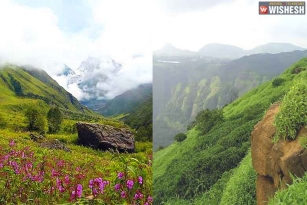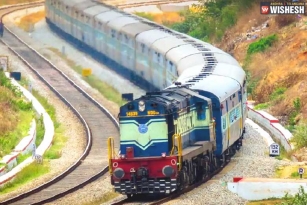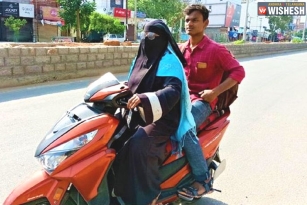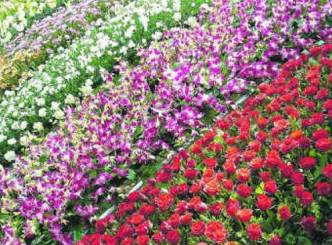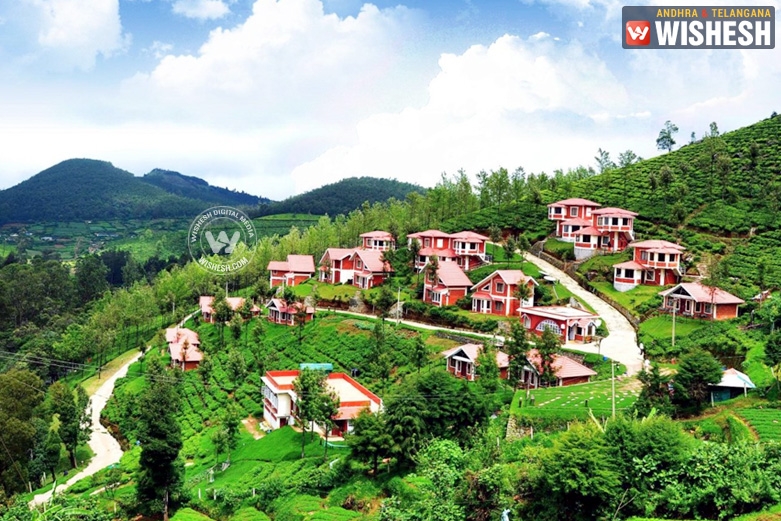
Udhagamandalam, sometimes abbreviated Udhagai and better known as Ooty, is a town, a municipality and the district capital of the Nilgiris district in the Indian state of Tamil Nadu. It is located around 80 km north of Coimbatore. It is a popular hill station located in the Nilgiri Hills. It is situated at an altitude of 2,240 meters (7,350 feet) above the sea level. The town's economy is based on tourism and agriculture, along with manufacture of medicines and photographic film. The town is connected to the rest of India by road and rail and its historic sites and natural beauty attract tourists.

Ooty is situated deep within the Nilagiri hills. ‘Nila’ means Blue and ‘Giri’ means Mountain. It is unknown whether this name arises from the blue smoky haze given off by the eucalyptus trees that cover the area or from the kurunji flower, which blooms once in every twelve years giving the slopes a bluish tinge. Nilgiris in general was ruled by Ganga kings and later by Hoysala kings, particularly Vishnuvardhana who captured Wynad and Nilgiri area during the 11th century. Tippu Sultan was the first to extend his border by constructing a hideout cave like structure.
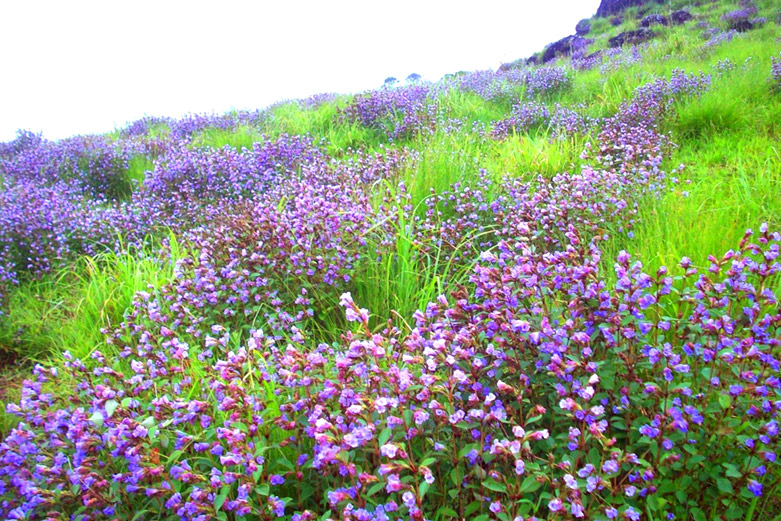
It was originally a tribal land and was occupied by the Todas along with other tribes who coexisted through specialisation and trade. Originally occupied by the Todas, the area came under the rule of the East India Company at the end of the 18th century. The major tribes of Nilagiri area are Toda, Kotas, Badagas and Alu Kurumbas, who are settled in and around Ooty. The first reference of Todas in Nilgiri is found in a record dated 1117 A.D. Toda people are known for raising water buffaloes and Badaga people for their farming activities.
Reachability
Ooty is well connected by good roads. It is 535 kilometres from Chennai (via Salem, Erode and Coimbatore), 80 kilometres from Coimbatore, 18 kilometres from Coonoor, 155 kilometres from Mysore (via Gudalur), 187 kilometres from Kozhikode, 290 kilometres from Bangalore (via Mysore), 281 kilometres from Kochi (via Coimbatore and Palakkad) and 236 kilometres from Kodaikanal (via Coimbatore and Palani). Ooty is situated on National Highway NH 67. It is connected by road from the states of Kerala and Karnataka via the five main accepted Nilgiri Ghat Roads. There is also a road from Mettupalayam (Coimbatore) to Ooty via Kotagiri and Manjur, which doesn't pass through Coonoor town.
By road
Nilgiris district has frequent buses connecting nearby towns in the district such as Coonoor, Kotagiri, and Gudalur. The town also has direct bus services to various cities and towns of Tamil Nadu, such as Coimbatore, Tirupur, Erode, Salem, Sathyamangalam, Karur, Dindigul, Chennai, Trichy, Tirunelveli, Madurai, Thanjavur, and Kanyakumari. There are several bus services to and from the nearby cities of Mysore and Kozhikode. Direct buses can be boarded for Ooty from many other parts of Karnataka and Kerala, such as Palghat, Nilambur and Sulthan Bathery in Kerala and Gundlupet in Karnataka. The capital cities of these two states (Bangalore and Thiruvananthapuram respectively) and Pondicherry are also connected via direct bus links.
By Rail
Ooty is connected by a lightly connecting train service. The railway station for Ooty is Udhagamandalam railway station. Mettupalayam provides the interchange between 'The Nilgiri Passenger' NMR metre gauge service and the Nilgiri Express broad gauge service. The Nilgiri Mountain Railway (NMR) is one of the oldest mountain railways in India. The NMR was declared by the UNESCO as a World Heritage Site in July 2005. This connects Ootacamund with the town of Mettupalayam, at the foothills of the Nilgiri Mountains. It is the only rack railway in India, which uses the Abt system.
By Air
Ooty does not have an airport. The nearest airports are Coimbatore 96 kilometres, Kozhikode 141 kilometres and Bangalore 309 kilometres. Ooty has three helipads, one at Theettukal and two at Kodanad. The Theettukal helipad was the closest to the town, approved by Airports Authority of India, used for defence and VIP services. The helipads at kodanad are located near Green Tea Estate and Kodanad Tea Estate.
History
The Nilgiri territory came into possession of East India Company as part of the ceded lands, held by Tipu Sultan, by the treaty of Srirangapatnam in 1799. Rev. Jacome Forico, a priest, was the first European who visited Nilgiris in 1603 and released his notes about the place and the people of Nilgiris. In 1812 surveyor William Keys and Macmohan visited the top of the plateau. In 1818, Wish and Kindersley, Assistant and Second Assistant to Collector of Coimbatore visited this spot and submitted their experience report to the Collector of Coimbatore John Sullivan. John Sullivan with his party proceeded to Nilgiri Mountain and camped at Dimbhatti, just north of Kotagiri in January 1819 and was enthralled by the beauty of the place.
John Sullivan wrote to Thomas Munro, "it resembles Switzerland, more than any country of Europe; the hills are beautifully wooded and fine strong spring with running water in every valley". Again in May 1819, Sullivan came to Ooty and began the construction of his bungalow at Dimbhatti (near Kotagiri), the first European dwelling on the hills. John Sullivan laid the path from Sirumugai to Dimbhatti in 1819 and the work was completed in May 1823. The route up to Coonoor was laid in 1830-32. Ooty served as the summer capital of the Madras Presidency and other small kingdoms, much visited by British during the colonial days. Today, it is a popular summer and weekend resort. Soldiers were also sent here and to nearby Wellington to recuperate. Its stunning beauty and splendid green deep valleys inspired the British to name it Queen of Hill Stations.
During the summer season, the Madras Government and its officials, the Governor and his family, stayed at the Government House in the Nilgiri Hills. Governor, Sir Arthur Lawley (1906-1911), was an accomplished horseman, a quality admired by the Indian princes of the Madras Presidency. He enjoyed hunting in the Ooty hounds and was frequently joined by close friends like the Maharajah of Mysore. The Governor’s Residence, Government House, was the focus of activity and there was a splendid Club House with a fine golf course, polo, swimming and tennis. Snooker is said to have originated on the billiard tables of the Ootacamund Club, invented by an army officer Sir Neville Francis Fitzgerald Chamberlain. There was also a cricket ground with regular matches played between teams from the Army, the Indian Civil Service and the business sector. There were riding stables and kennels at Ooty and the Ootacamund Hounds hunted across the surrounding countryside and the open grasslands of the Wenlock Downs, named after Sir Arthur Lawley’s brother Beilby Lawley, 3rd Baron Wenlock. There were Point to Point Races and Gymkhanas, and horse riding was a very popular pastime. The maharajas, the business fraternity and the senior civil servants had summer cottages at Ooty. The misty blue haze of the Nilgiri Hills, and the fragrant mountain rains are a welcome change from the sultry heat of Madras.
Ooty is reached via winding hill roads or a complicated rack railway system, known as the Nilgiri Mountain Railway, built in 1908 by impassioned and enterprising British citizens with venture capital from the Madras government. In 1882, a Swiss engineer named Arthur Riggenbach came to the Nilgiri Hills on an invitation from Government of India and he submitted detailed estimates for a line costing £132,000. A local company named “The Nilgiri Rigi Railway Co. Ltd.” was formed, and the Government offered it free land. This company insisted on a guaranteed return of 4%, which was not acceptable, and the proposed railway, once again, had to be shelved. In 1885, another Nilgiri Railway Company was formed and in 1886, planning work commenced, using the Abt system with two adjacent toothed rails in the centre of the one metre gauge track. The work on the line commenced in August 1891 when Sir Arthur Lawley’s brother, Beilby Lawley, 3rd Baron Wenlock, the then Governor of Madras, turned the first turf to begin construction.
The Mettupalayam - Coonoor section of the track was opened for traffic on 15 June 1899. In January 1903, the Indian Government purchased the line and took over the construction of the new extension from Coonoor to Ooty. The Nilgiri Mountain Railway was operated by the former Madras Railway Company until 31 December 1907 on behalf of the Government. In January 1908, the railway line was handed over to South Indian Railways. The line from Coonoor to Fernhill was completed on 15 September 1908 and reached Ooty, one month later. On October 15, Sir Arthur Lawley, Governor of Madras, officiated at the opening ceremony of the new railway to Ootacamund.
Climate
Ooty features a subtropical highland climate under Koppen climate classification. Ooty generally features pleasantly mild conditions throughout the year. However, nighttime in the months of January and February is typically cold. Generally, the town appears to be eternally stuck in the spring season. Temperatures are relatively consistent throughout the year; with average high temperatures ranging from about 17–20 °C (63–68 °F) and average low temperatures between approximately 5–12 °C (41–54 °F). The rainy season in Ooty is generally very cool and windy with high humidity. The wind-chill may fall to as low as 5°C during the day time.
Language
Tamil is the main language of Udhagamandalam. Languages native to the Nilgiris like Badaga and Paniya are also spoken by the tribes. Due to its proximity to the neighbouring states and it being a popular tourist spot, English, Kannada and Malayalam are also spoken and understood to an extent.
Places to Visit
1. The Government rose garden is the largest rose garden in India. It is situated on the slopes of the Elk Hill in Vijayanagaram of Ooty town. This garden has one of the largest collections of roses in the country with more than 20,000 varieties of roses of 2,800 cultivars. The collection include Hybrid Tea Roses, Miniature Roses, Polyanthas, Papagena, Floribunda, Ramblers, Yakimour and roses of unusual colours like black and green.
2. The 22-acre Ooty Botanical Gardens was laid out in 1847 and is maintained by the Government of Tamil Nadu. The Botanical Garden is lush, green, and well-maintained. A flower show along with an exhibition of rare plant species is held every May. The Gardens have around a thousand species, both exotic and indigenous, of plants, shrubs, ferns, trees, herbal and bonsai plants. The garden has a 20-million-year-old fossilized tree.
3. Ooty Lake covers an area of 65 acres. The Boat house established alongside the lake offers boating facilities to tourists and is a major tourist attraction in Ooty. It was constructed in 1824 by John Sullivan, the first collector of Ooty. The lake was formed by damming the mountain streams flowing down Ooty valley. The lake is set among groves of Eucalyptus trees with a railway line running along one bank.
4. Stone House is the first bungalow constructed in Ooty. It was built by John Sullivan and was called as Kal Bangala by the tribals. John Sullivan started building Stonehouse in 1822, acquiring land from the Todas at one rupee an acre.

5. There are a few Toda huts on the hills above Botanical Garden, where Todas still dwell. There are other Toda settlements in the area, notably Kandal Mund near Old Ooty.

6. The Nilgiri Mountain Railway was built by the British in 1908 and was initially operated by the Madras Railway Company. The railway still relies on its fleet of steam locomotives. NMR comes under the jurisdiction of the newly formed Salem Division. In July 2005, UNESCO added the Nilgiri Mountain Railway as an extension to the World Heritage Site of Darjeeling Himalayan Railway after it has satisfied the necessary criteria.
7. A wax museum that houses life-size look-alike wax statues of personalities of Indian history, culture and heritage is housed in a 142-year-old bungalow, located in the Ooty -Coonoor road.
8. The Tribal Museum is part of the campus of Tribal Research Centre which is in Muthorai Palada (10 km from Ooty town). It is home to rare artifacts and photographs of tribal groups of Tamil Nadu as well as Andaman and Nicobar Islands and anthropological and archaeological primitive human culture and heritage. The Tribal Museum also displays houses belongs to Toda, Kota, Paniya, Kurumba and Kanikarans.
9. Deer Park is located on the edge of Ooty Lake. It is considered as one of the high altitude zoo in India aside from the zoo in Nainital, Uttarakhand.
10. Doddabetta Peak is the highest peak (2,623 m) in the Nilgiris, about 10 km from Ooty. One can have a panoramic view of the landscape through the TTDC telescope. TTDC restaurant caters the needs of tourists.
11. Pykara is a river located 19 km from Ooty. The Pykara River rises at Mukurthi peak. The river flows through a series of cascades; and the last two falls of 55 meters and 61 meters are known as Pykara falls.
12. Pine forest is situated between Ooty and Thalakunda, this tourist destination is featured in many movies. It is a small downhill region where pine trees are arranged in an orderly fashion.
13. Wenlock Downs is a grassland area typical of the original bioscape of the Nilgiris. It has gently undulating hills and is often compared with areas in the British isles such as the Yorkshire Dales.
14. Mudumalai National Park, now also declared a Tiger Reserve, lies on the northwestern side of the Nilgiri Hills (Blue Mountains), in Nilgiri District. Mudumalai, which means 'first hills’, is one of the first wildlife sanctuaries established in India. The sanctuary is divided into 5 ranges - Masinagudi, Thepakadu, Mudumalai, Kargudi and Nellakota. Here one can often spot herds of endangered Indian elephants, vulnerable Gaur, and Chital. The sanctuary is a haven for Bengal Tigers and Indian Leopards and other threatened species. There are at least 266 species of birds in the sanctuary, including critically endangered species like the Indian White-rumped Vulture and the long-billed vulture.
15. Mukurthi National Park is a 78.46 sqkm protected area located in the south-eastern corner of the Nilgiris Plateau west of Ooty. The park is a part of Nilgiri Biosphere Reserve, India's first International Biosphere Reserve.
16. Needle hill viewpoint is situated between Gudalur and Pykara.
17. Frog Hill Viewpoint got its name as hill looks like a frog sitting on slopes of mountains.
18. Emerald Lake is near the town of the same name. There is a viewpoint near the dam.
19. Avalanche Lake is adjacent to Emerald Lake. This picturesque lake is mainly situated in a reserved forest.
20. Porthimund Lake is mostly in a reserved forest.
21. Upper Bhavani Lake is in the Mukurthi National Park.
By Premji






